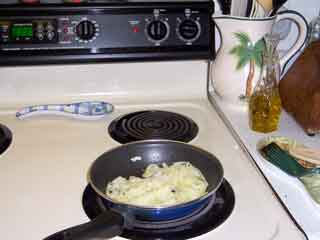Here’s what you need . . .
onion(s), sliced
butter
pinch of coarse (Kosher) salt, optional
Tellicherry, optional
time
Here’s how you do it.
The secret to carmelization is time, and low heat. There are no shortcuts. If you can’t wait at least an hour, maybe more, do something else with your onions. I’m usually working with one onion (or less if I’m cooking for just myself), and I plan on about 90 minutes from inspiration to plate. Depending on how many onions you’re dealing with and the size of your biggest skillet, you might need up to two hours.
Now only about 60 or 70 of those minutes are on the stove. The rest are consumed with deciding how the onions are to be incorporated into the meal (or maybe, what the rest of the meal is going to be in the first place!), getting out implements, peeling and slicing an onion, finding butter, warming the skillet, and generally futzing around.
So slice an onion (or 6). I like slices about ¼” wide, but anything from hair’s breadth to half an onion will work. Because you’ll be taking your own sweet time, the size of the slice doesn’t matter to the cooking time. So slice an onion (or 6 . . . )
And heat your skillet over moderate heat for a while (no more than a minute or two, if you’re using a nonstick skillet!), toss in a tablespoon or so of butter, and swirl once or twice.

Now dump in your onions

and turn the heat down.

Stir it all around to coat with butter. Then, add some more butter.

From here on in, it’s just a waiting game. After 3 more minutes, your butter is getting soft. After 8 minutes, it’s melted in

and you should turn the heat down again.

Now, just toss and stir every five or ten minutes for the rest of the hour. Here’s what you look like after 15 minutes . . .

If you’re going to add a pinch of salt and some pepper, somewhere around 20 minutes is a good time to do it. If you add the salt too early, you’ll alter the chemistry, and end up with crispy fried onions – tasty, but not carmelized. The salt draws the water out of the onion where it evaporates in the pan instead of helping to form sugars. But by 20 minutes into the process, most of the sugars have been formed and released by the onion, so your salt will have its flavor enhancing effect. And Tellicherry, well, hey I put it on ice cream . . . Here’s how your onions look after 35 minutes . . .

And after 60 . . .

I’d call ‘em done, but if you want to leave them on for a while longer, that’s fine – just turn the heat down again

Whenever you decide, serve ‘em up as a side dish on their own, or pour them on potatoes, or mix them up with green beans or your veggie of choice, or top a steak or piece of grilled fish with them, or serve ‘em on toast and call it dinner!
There ain't nothing like carmelized onions.
ReplyDelete